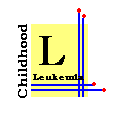

Leukaemia can be divided into two main types - the acute leukaemias and the chronic leukaemias. Both of them have very different subtypes. The main difference between the two is that chronic leukaemias are less urgent and slower-growing than acute leukaemias. They can be present for several years without producing any noticeable symptoms.
Acute Leukaemias
Acute leukaemia cases account for a major part of childhood leukaemia cases. They can be classified into:
1) Acute Lymphoblastic Leukaemia (also known as acute lymphocytic or acute lymphoid leukademia)
2) Acute Myeloid Leukaemia (also known as acute granulocytic leukaemia)
Acute Lymphoblastic Leukaemia (ALL)
General information and classifacation
ALL is a disease in which there is leukaemic transformation of lymphocytes. In ALL, rather than maturing and becoming infection fighters for the body, the lymphocytes remain immature and increase in number. They crowd out healthy white cells, red cells and platelets.
This is the most common type of leukaemia in children, accounting for about 70% of all childhood leukaemia cases. Often treatable and curable, a great majority of patients can be cured with modern therapy. The peak incidence of this type of leukaemia is about 2 to 9 years of age.
ALL can further be classified into 3 principal subtypes - L1, L2 and L3. L1 occurs mainly in children , L2 occurs in children and adults and L3 is a rare type that in biological behavior is similar to Burkitt's lymphoma.
Factors that influence treatment
Features of lymphoblasts and abnormalities of chromosomes, which are important in subclassifying ALL, can affect the type and intensity of the therapy to be used as well as the likely course of the disease. Additional features like the age and general health of the patients are also important in guiding therapy.
2) Acute Myeloid Leukaemia
AML is a cancer of the granulocytes, a type of white cell. Accounting for about 15% of all childhood leukaemias, AML is also known as acute non-lymphoblastic leukaemia (ANLL).
Normally, the granulocytes would mature and take on roles as the body's infection fighters. In the body of a child who has AML, the granulocytes turn cancerous, remain immature and increase in number. They crowd out the healthy white cells, the red cells and platelets.
AML can be divided into 8 subtypes. The subclassification of AML is important as different therapies may be applied to different subtypes. Additional features like the abnormalities present in the chromosomes, the cell immunophenotype, the age and general health of the patients may also be important in the choice of therapy.
M1 mylogenous type
This is the most common type in the first few months of life. Anemia and thrombocytopenia are present in above 80% of all mylogenous leukaemias. Leukocytosis occurs in more than 30% of patients.
Acute mylogenous leukaemia (M2) and Acute promyelocytic leukaemia (M3)
Occurs in middle-aged patients.
Acute myelomonocytic leukaemia (M4)
Uncommon in children and young adults.
Acute monocytic leukaemia (M5)
Pure monocytic leukemia is rare in patients. Two forms, M5A and M5B have been distinguished. M5A is the most common in young adults and M5B is most common in middle age. This form of leukemia is very resistant to therapy and the life expectancy is very short, about 5 to 8 months, depending on the type.
Erythroleukaemia (M6)
Usually occurs in older people.
Acute megakaryoblastic leukaemia (M7)
Acute myeloid leukaemia with minimal differentiation (M0)
Chronic Leukaemias
Chronic Lymphoblastic Leukaemia (CLL)
CLL is also known as Chronic Lymphoblastic, Chronic Lymphogenous or Chronic Lymphoid Leukaemia. It is extremely rare among the Oriental races, and has never been reported to occur in children. CLL is predominantly a condition of the older age group with about 90% of cases occurring after the age of 50, and incidence increses with age. Two thirds of those affected are men.
Because it is chronic, it is slow-moving and less alarming than almost any other form of cancer or leukaemia. Cancers of lymphocytes in general (and particularly CLL) are almost always responsive to chemotherapy.
CLL is a malignant disorder involving a progressive accmulation of small, mature-appering lymphocytes in blood, lymph nodes, spleen and bone marrow. The true cause of CLL are unknown. In most cases, CLL causes no problems or symptoms at the time of diagnosis - a state that may continue for a long time.
Chronic Myeloid (or Granulocytic) Leukaemia (CML/CGL)
Chronic Granulocytic Leukaemia is like CLL, a slow-moving condition which may not cause symptoms or problems for a long time. In general, it progresses more steadily (and more rapidly) than CLL, so treatment is somewhat different. At diagnosis, there is usually a massive increase in their concentration in the blood. Unlike Acute Myelogenous Leukaemia, CML permits the development of mature white blood cells that generally can function normally. This accounts for the less severe early course of the disease.
CML is a condition that occurs in adulthood and the later years. CML accounts for about 4% of childhood leukaemia cases. It is more common in the 50s and older, although it can occur in the 30s and 40s.